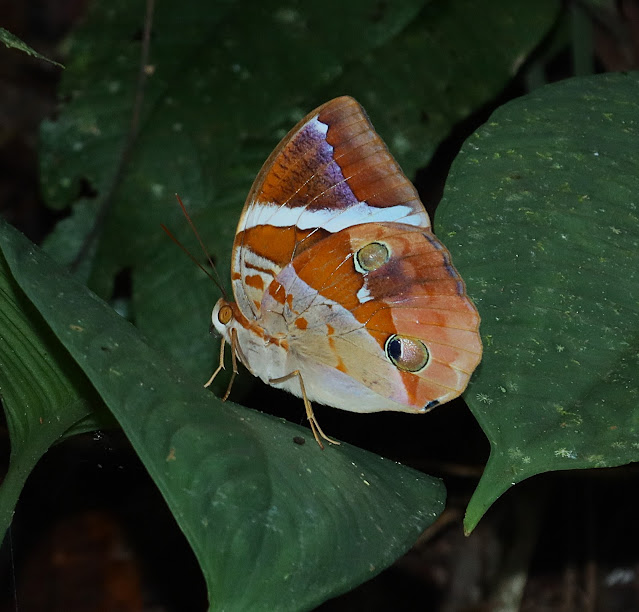Although there were not many lifers in July 2024 but one lifer which I've wanted to see for a long time stood above the rest of them.
Blue Nawab
(Polyura schreiber tisamenus)
At first it was flying very fast in a circle. I think it has probably seen me walking towards its direction. In flight it appears whitish like a Chocolate Albatross but larger. I nearly ignore it but luckily it lands on the ground. Curious on what it would be, I walk slowly towards it and my mouth was wide open upon seeing what I saw on the ground. It's a Blue Nawab man !
Blue Nawab
(Polyura schreiber tisamenus)
Fearing that it might get spooked, I took a couple of long distance shots like about 6 m away. Inch by inch I moved slowly towards it and finally got close to just about 1m. I believe there are only a handful of photos of this Nawab in this region. Two weeks later, I went back to the same location but its no longer around so as the 'food' it was consuming earlier. This should be a major lifer for me for many years to come.
White-banded Awl
(Hasora taminatus malayana)
Not too far away from the above Blue Nawab, I saw this Hasora. It was seen hanging upside down at a low bush inside a thick foliage.
Malayan Lacewing
(Cethosia hypsea hysina)
Together with most Lacewings, they are commonly found on hilly areas.
Malayan Lacewing
(Cethosia hypsea hysina)
This Cethosia was seen at a lowland hill just outside KL.
Once awhile you will get to see this. They are not as common as Plum Judy (Abisara) although they can be seen together in the same location.
Malayan Tailed Judy
(Abisara savitri savitri)
Wax Dart
(Cupitha purreea)
Described as either 'rare' or 'uncommon' by many literatures, I was wondering when will I get to see this Dart. Suddenly saw them twice in 2 months. Both at different locations.
It appears like the month of July is the season for Poritia & Simikina.
This is a Common Gem
(Poritia hewitsoni taleva)
(Poritia philota philota)
Malayan Gem
A tiny Gem.
Malayan Gem
(Poritia philota philota)
Usually I have only seen them opening half their uppersides.
They can be quite skittish as well.
Blue Line Brilliant
(Simiskina pharyge deolina)
This is a rare Simiskina.
Blue Line Brilliant
(Simiskina pharyge deolina)
It too hardly open its wings.
Poritia promula elegans?
Apparently it's a Sumatran Gem - Poritia sumatrae !
Sumatran Gem
Poritia sumatrae
P. promula is said to be common in hilly areas so the above is not a P. promula.
Sumatran Gem (Poritia sumatrae)
Due to its odd looking wing shape I had some difficulty to identify this species until a more experienced member pointed it out to me. This could be a female.
Dark Evening Brown
(Melantis phedima abdullae)
Dark Evening Brown
(Melantis phedima abdullae)
This is a male. Seen at a different location from the above female.
Pale-marked Ace
(Halpe hauxwelli)
You probably only see this Halpe in an inland jungle.
Pale-marked Ace
(Halpe hauxwelli)
Apparently Halpe do take artificial baits like belacan as well.
Swinhoe Ace
(Halpe wantona)
This 'Ace' is slightly smaller than the above one.
Linna Palm Dart
(Telicota linna)
The above ID has been corrected from the earlier ID which was a Plain Palm Dart.
This is an uncommon skipper.
Male (Left), Female (Right)
Blue-banded Jungle Glory
(Thaumantis odana pishuna)
This butterfly can be quite friendly if you approach them slowly while they are puddling. You can basically fill up your SD card with their photos.
Here is another pristine beauty
Tufted Jungle King
(Thauris aliris pseudaliris)
Red Harlequin
(Paralaxita telesia)
Initially I thought I will just skip this species cause first, it is quite tiny and second I have got a lot of its photos I thought. Since it was posing nicely for me so I thought maybe I just give it a few shots. Due to its size and non-stop flying, I found it quite difficult to get a clear photo until it stop momentarily. Only when I look further at its photos at home I found that it is not what it seems to be.
This is actually a Blue Quaker (Pithecops fulgens fulgens).
So happy that I got this shot to confirmed its identity. Definitely a Lifer for me!
Blue Quaker
(Pithecops fulgens fulgens) / (Pitheceops fulgens fulgens)
Coconut Skipper
(Hidari irava)
This skipper was actually seen near a wild ginger plant.
Tailed Disc Oakblue
(Arhopala atosia jahara)
Tailed Disc Oakblue
(Arhopala atosia jahara)
Golden Oakblue
(Arhopala phanda)
Golden Oakblue
(Arhopala phanda)
Here is something different. Apparently this is a Common Flying Lizard (Draco sumatranus). It was seen on the ground. I believe it's a female.
Lastly I leave this month's post with this grumpy old man.
Narrow Spark
(Sinthusa nasaka amba)
ADIOUS SENOR AND SENORITAs!



































































































